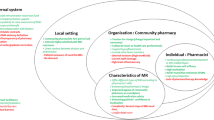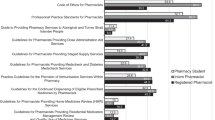Abstract
Objective To explore the usefulness and implementation of practice standards in community pharmacy practice regarding contemporary core services. Setting Community pharmacies in South East Queensland, Australia. Method During August and September 2006 semi-structured interviews with community pharmacists explored practice processes and procedures and the utilisation of endorsed standards and guidelines. Thematic content analysis of the interviews, inductive analysis and continual comparison of categories and concepts enabled common and distinct themes to be clarified. Main outcome measure Usefulness and integration of practice standards in the provision of core pharmacy services, utilisation of support staff, record keeping and overall risk management processes in community pharmacy. Results Seventeen community pharmacists participated, representing a wide range of demographics, experience and pharmacy types. Staff utilisation and record keeping practices were analysed as well as two core services, namely: (1) the supply of over-the-counter medicines, and (2) the dispensing of prescriptions. The procedures followed concerning the supply of over-the-counter medicines varied. The majority of participants did not regard this as a pharmacist’s immediate role, but rather relied on support staff to identify when the supply required a pharmacist’s intervention. Whilst all participants involved dispensary assistants in the dispensing process, the delegation of procedures differed. Most participants did not clearly differentiate between pharmacists’ and dispensary assistants’ activities. Dispensing processes and the involvement of pharmacists in the provision of patient advice varied. Pharmacist intervention record keeping was uncommon and records of ‘near misses’ were not routinely kept by any of the participants. Conclusion A lack of integration of practice standards indicated a need to review the standards for relevance. Additionally, pharmacists need to re-evaluate workflow models and the delegation of tasks in the light of new roles and responsibilities.

Similar content being viewed by others
References
Benrimoj S, Frommer MS. Community pharmacy in Australia. Aust Health Rev. 2004;28:238–46.
Albrecht L, Roberts A, Benrimoj C, Williams K, Chen T, Asani P. Cognitive pharmaceutical services: financial facilitators. Aust Pharm. 2006;25:809–15.
Berbatis CG, Sunderland VB, Joyce A, Bulsara M, Mills CR. Enhanced pharmacy services, barriers and facilitators in Australia’ community pharmacies: Australia’s National Pharmacy Database Project. Int J Pharm Pract. 2007;15:185–91. doi:10.1211/ijpp.15.3.0005.
Niselle P. Managing medical indemnity: must we choose between quality assurance and risk management? Med J Aust. 2004;181:64–5.
Donabedian A. Medical care appraisal—quality and utilisation. Washington DC: American Public Health Association; 1969. p. 2.
Standards Association of Australia. Australian/New Zealand Standard—risk management: AS/NZS 4360. Homebush, NSW: Standards Australia International Limited; 2004.
Standards Association of Australia. Australian/New Zealand Standard—handbook: risk management guidelines: companion to AS/NZS 4360. Homebush, NSW: Standards Australia International Limited; 2004.
Hattingh HL, Smith NA, Searle J, King MA, Forrester K. Regulation of the pharmacy profession throughout Australia. J Pharm Pract Res. 2007;37:174–7.
Pharmacists Board of Queensland. Bulletin No. 24. PBQ. 2007. http://www.pharmacyboard.qld.gov.au/publications.htm. Cited 15 January 2007.
Pharmaceutical Society of Australia. Australian pharmaceutical formulary and handbook. 20th ed. Canberra: Pharmaceutical Society of Australia; 2006. p. 445–97.
Newgreen DB, Pressley JA, Marty SH. A survey of dispensing errors reported to the Pharmacy Board of Victoria, July 1998 to December 2004. Aust Pharm. 2005;24:644–8.
Benrimoj SA. Cost-benefit analysis of pharmacist only (S3) and pharmacy medicines (S2) and risk-based evaluation of the standards. Aust Ins Health Ageing. 2006. http://www.beta.guild.org.au/research/project_display.asp?id=246. Cited 3 June 2006.
Pharmaceutical Society of Australia. Professional practice standards. 3rd ed. Curtin: Pharmaceutical Society of Australia; 2006. p. 43–9.
Pharmaceutical Defence Limited (PDL). Guide to good dispensing. PDL. 2005. http://www.pdl.org.au/mediacentre/dispensing_guide. Cited 12 December 2006.
Pharmacy Guild of Australia. Quality care pharmacy program (QCPP). PGA. 2006. http://beta.guild.org.au/qcpp/. Cited 21 September 2006.
Kinrade W. Workforce and career options for pharmacy assistants (Report). Collingwood, Victoria: Healthcare Management Advisors; December 2004.
Berbatis CG, Sunderland VB, Joyce A, Bulsara M, Mills CR. National pharmacy database project. 2003. http://beta.guild.org.au/research/project_display.asp?id=239. Cited 15 January 2008.
Hattingh L, Forrester K, Smith N, Searle J. Pharmacy practice developments: the potential impact on pharmacists’ legal liability. J Law Med. 2007;14:297–402.
Hattingh HL. An investigation of community pharmacy risk management regulation and practices in the context of an expanding role (Dissertation). Gold Coast, Australia: H.L.Hattingh; 2007.
Pharmaceutical Society of Australia. Standards for the provision of pharmacy medicines and pharmacist only medicines in community pharmacy. 2nd ed. Curtin: Pharmaceutical Society of Australia; 2005.
Smith A, McLachlan A. Generic medicines: same difference? National Prescribing Service; 2006, February: 1–4.
Pharmacists Board of Queensland. Policy: dispensary assistants. Pharmacists Board of Queensland. 2006. http://www.pharmacyboard.qld.gov.au/Publications/Policies/Dispensary%20Assistants%202005.pdf. Cited 15 January 2007.
Merriam SB. Qualitative research in practice: examples for discussion and analysis. San Francisco: Jossey-Bass; 2002.
Patton MQ. Qualitative research & evaluation methods. 3rd ed. London: Sage; 2002. p. 125. ISBN 0-7619-1971-6.
Galbally R. Final report of the review of drugs, poisons and controlled substances legislation (Report). Woden, ACT: Secretariat, Review of Drugs, Poisons and Controlled Substances Legislation; 2001.
Strand L. Building a practice in pharmaceutical care. Pharm J. 1998;260:874–6.
Peterson GM, Liauw C, Elkerton J, McKenzie D, Fitzmaurice K. Development and evaluation of a computerised system for the provision and documentation of pharmacists’ cognitive services. 2003. http://beta.guild.org.au/research/project_display.asp?id=269. Cited 25 June 2007.
Gross Z. Benefits of recording interventions. Pharm J. 2001;267:188.
Westerlund TLO, Handl WHA, Marklund BRG, Allebeck P. Pharmacy practitioners’ views on computerized documentation of drug-related problems. Ann Pharmacother. 2003;37:354–60. doi:10.1345/aph.1C182.
Pharmacy Guild of Australia. Professional pharmacy services. 2008. http://www.guild.org.au/pps/. Cited 15 March 2007.
Australian Primary Care Collaborative. The improvement model. 2007. http://www.apcc.org.au/. Cited 14 January 2008.
Acknowledgements
The 17 community pharmacists who participated in the interviews.
Funding
The participant interviews were funded through a Queensland Pharmacy Research Trust grant.
Conflict of interest
None.
Author information
Authors and Affiliations
Corresponding author
Rights and permissions
About this article
Cite this article
Hattingh, H.L., King, M.A. & Smith, N.A. An evaluation of the integration of standards and guidelines in community pharmacy practices. Pharm World Sci 31, 542–549 (2009). https://doi.org/10.1007/s11096-009-9309-9
Received:
Accepted:
Published:
Issue Date:
DOI: https://doi.org/10.1007/s11096-009-9309-9




